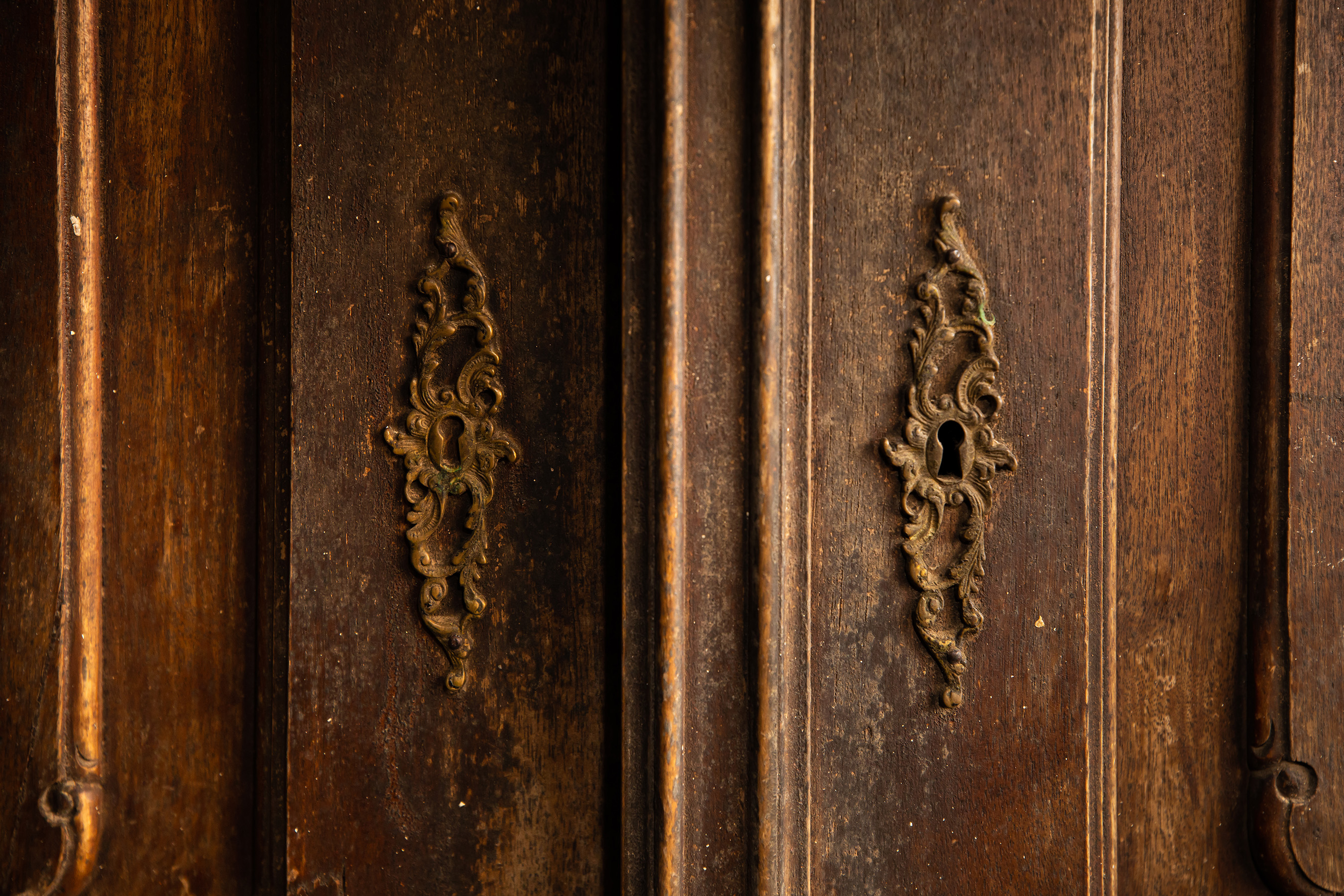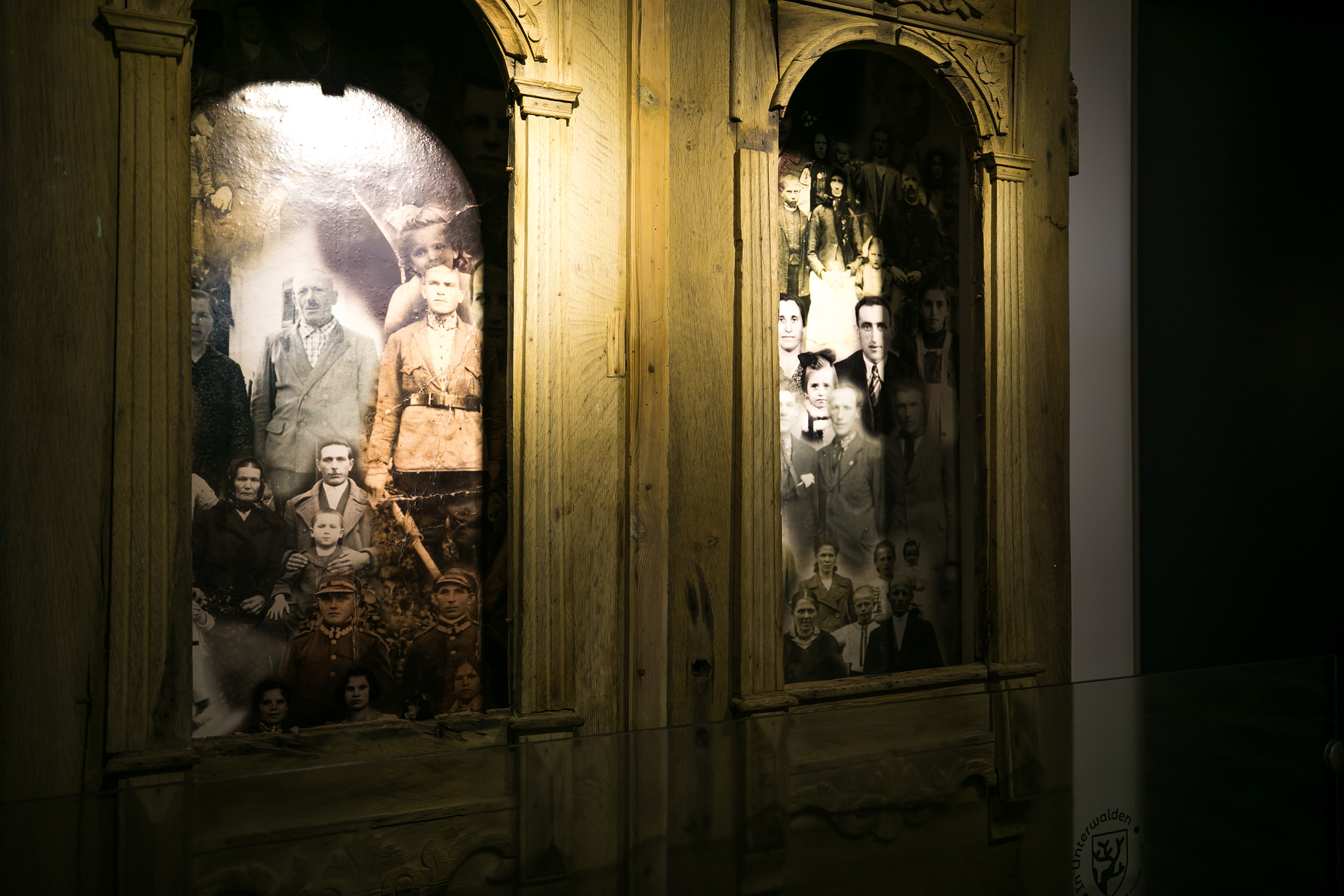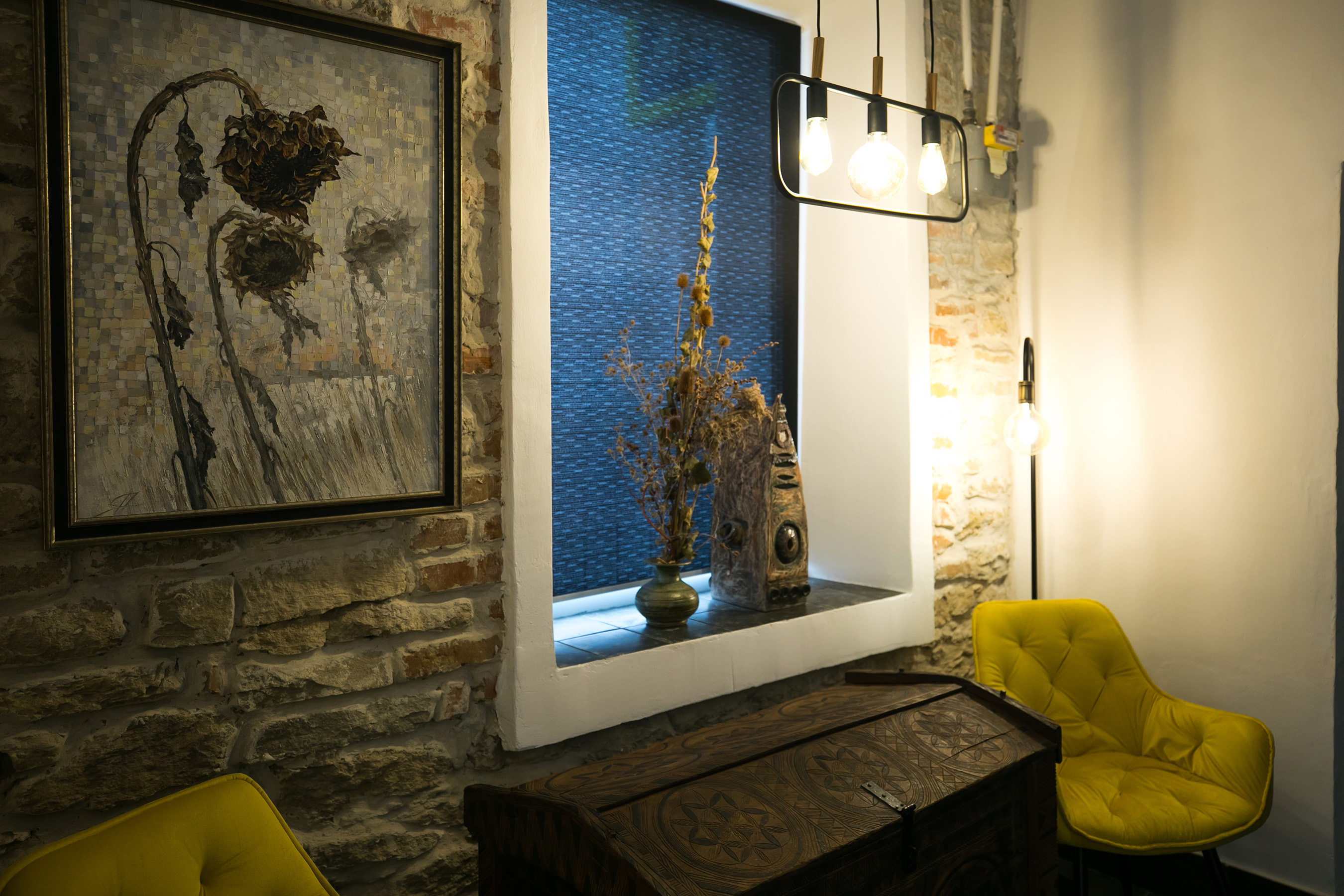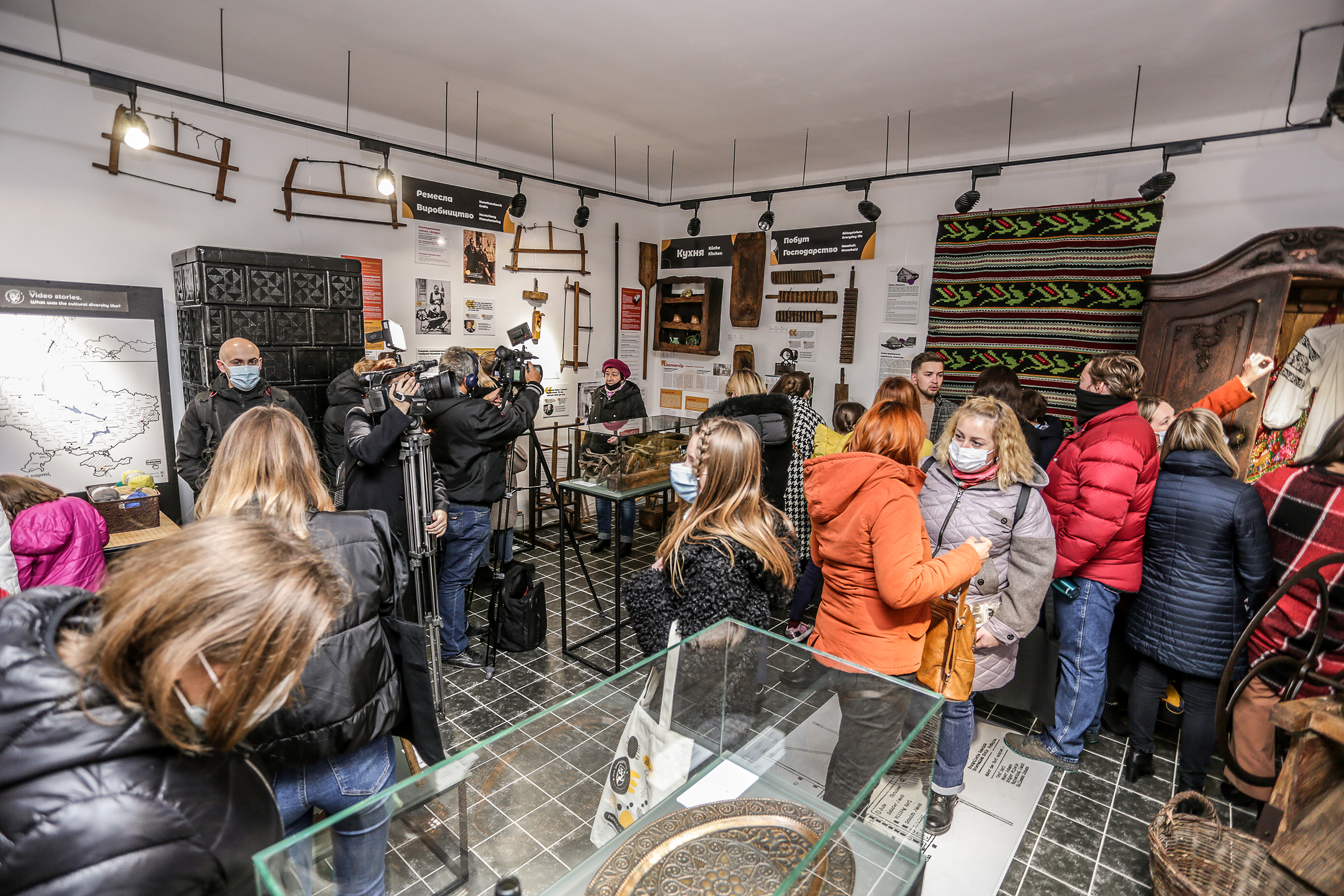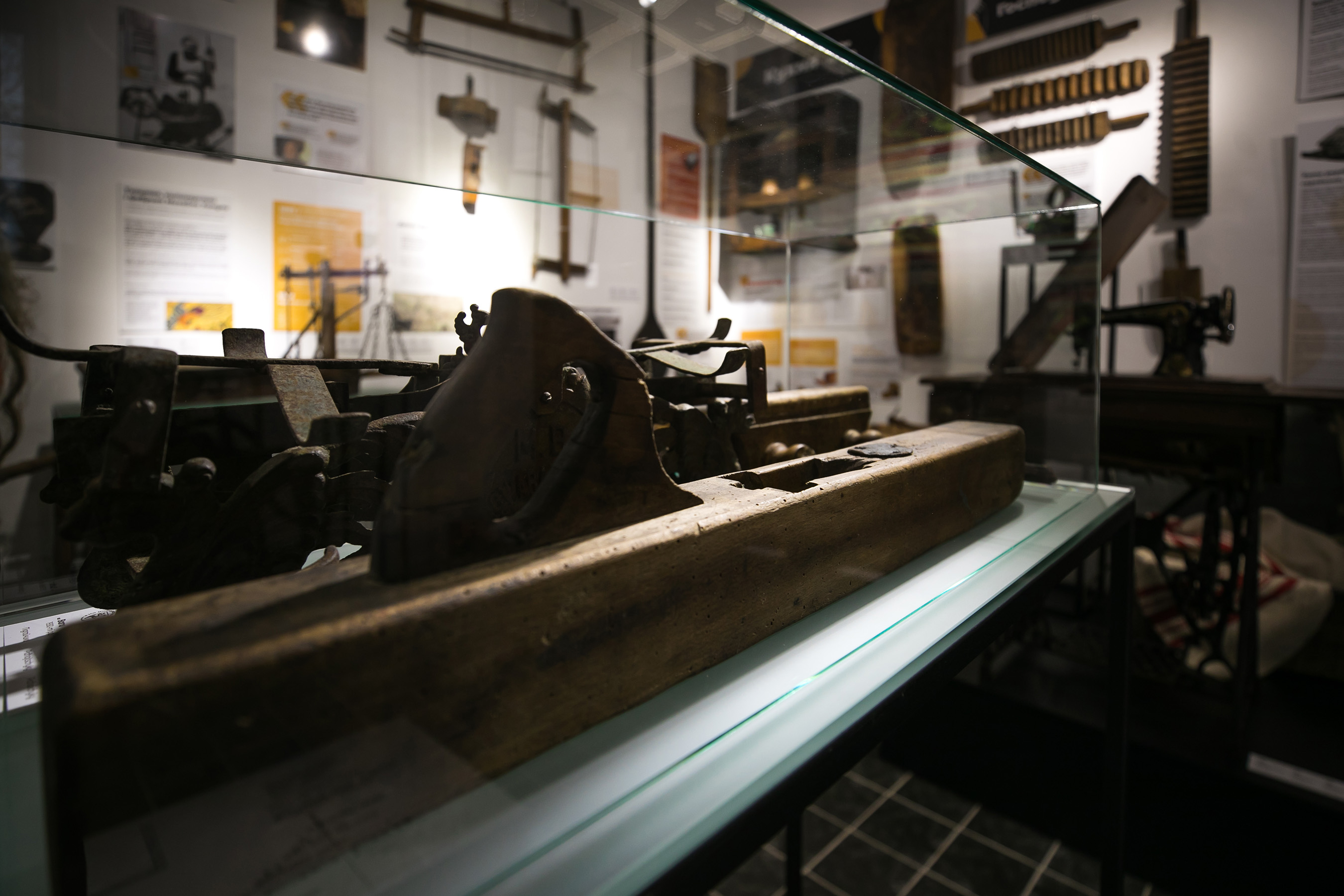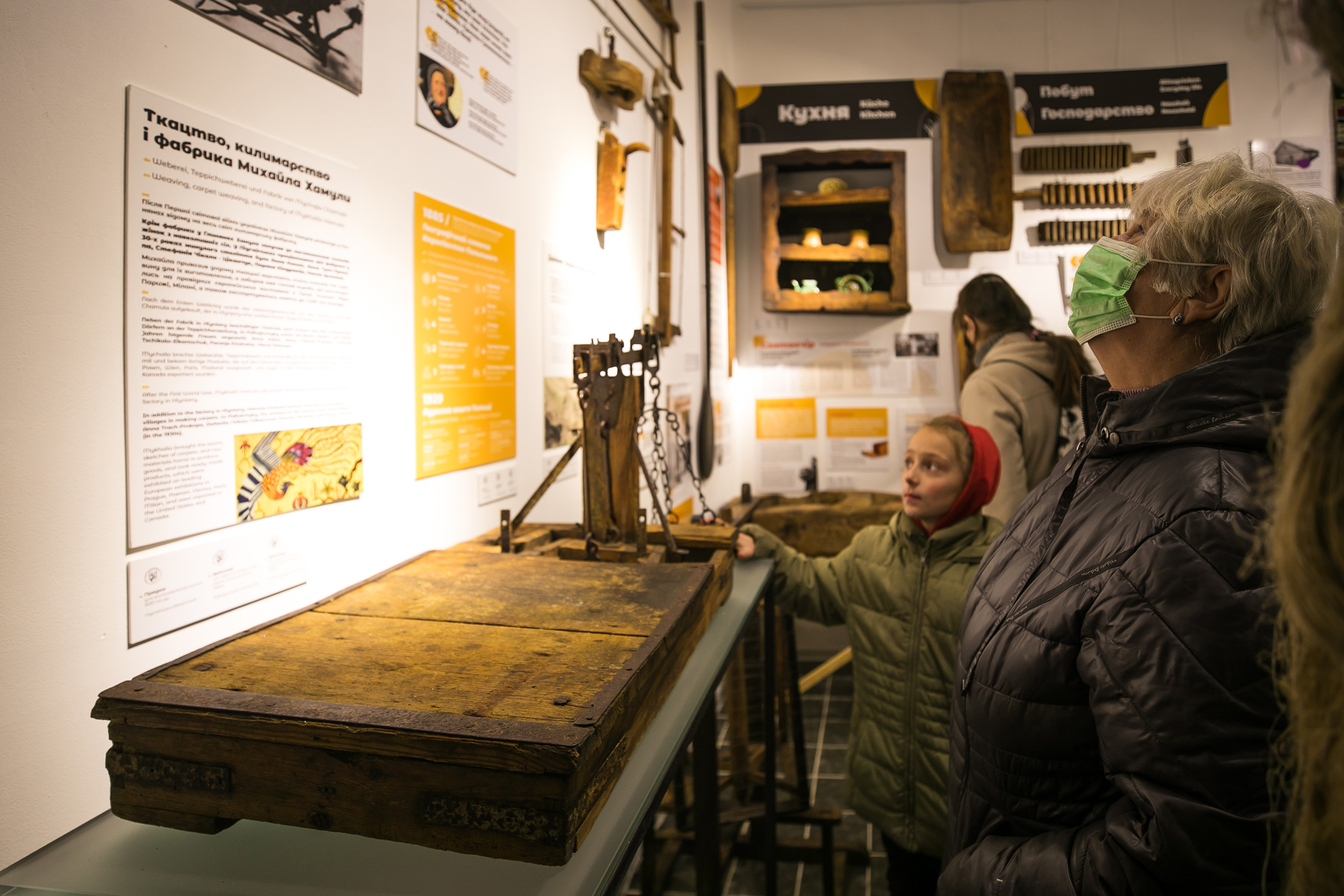Regaining a sense of belonging
The Unterwalden Cultural and Museum Cent
Development of memory culture and promote the multicultural heritage of the Galicia region at The Un
The project fosters a culture of memory and promotes the multicultural heritage of Galicia in Ukraine.
Since 2017, we have researched how Ukrainians, Poles, Jews, and Germans built multicultural communities in the villages of Galicia, focusing on education, religion, entrepreneurship, and cultural ties. We also preserve tangible and intangible cultural heritage and create a space for local community development.
Our approach is based on dialogue, respect for human dignity, and solidarity.
Since 2017, we have researched how Ukrainians, Poles, Jews, and Germans built multicultural communities in the villages of Galicia, focusing on education, religion, entrepreneurship, and cultural ties. We also preserve tangible and intangible cultural heritage and create a space for local community development.
Our approach is based on dialogue, respect for human dignity, and solidarity.
Ukraine
Regional
Lviv Oblast, Ukraine
Mainly rural
It refers to a physical transformation of the built environment (hard investment)
Yes
2021-12-01
No
No
No
As a representative of an organisation
The project creates a platform for exploring and rethinking Galicia's multicultural history. Located in a historical building, the center uses traditional local ecological materials to promote authenticity and sustainability.
The UWCH engages locals, tourists, researchers, and artists. It interprets history and heritage without stereotypes, nurtures contemporary culture, and fosters responsible attitudes toward cultural heritage. The re-exposition offers visitors exploring the history of Ukrainians, Germans, Poles, and Jews, inspires them to preserve their family heritage, and invites them to co-create the museum.
Goal: Modernizing The UWCH in Pidhaychyky, Lviv Region, for an innovative, participatory presentation of Galicia's cultural diversity, based on local history. Objectives: Create an innovative exhibition presenting Galicia’s multiculturalism and ensuring visitor participation. Facilitate interaction between visitors and the exhibition. Expand the center’s capacity as a local event platform to improve public events and build community. Promote the re-exposition to attract new audiences and enhance communication.
Target audience: Local community: 9,500 residents of Hlyniany, including 870 schoolchildren, 25 local activists and volunteers. Tourism businesses: approx. 50,000 clients in the Lviv region. Galician German organization members: 350 people. Museum visitors: 2,000-3,000 annually.
The project emphasizes human rights, dignity, and cultural diversity. The exhibition promotes tolerance, equality, and national minorities as co-creators of local history. The space is barrier-free, child-friendly, and accommodates people with limited mobility. The project has positively influenced local attitudes toward heritage, encouraging the exploration and preservation of family cultural heritage. The comms campaign has raised awareness of contemporary cultural practices in rural areas, challenging stereotypes of rural culture being less advanced than urban culture.
The UWCH engages locals, tourists, researchers, and artists. It interprets history and heritage without stereotypes, nurtures contemporary culture, and fosters responsible attitudes toward cultural heritage. The re-exposition offers visitors exploring the history of Ukrainians, Germans, Poles, and Jews, inspires them to preserve their family heritage, and invites them to co-create the museum.
Goal: Modernizing The UWCH in Pidhaychyky, Lviv Region, for an innovative, participatory presentation of Galicia's cultural diversity, based on local history. Objectives: Create an innovative exhibition presenting Galicia’s multiculturalism and ensuring visitor participation. Facilitate interaction between visitors and the exhibition. Expand the center’s capacity as a local event platform to improve public events and build community. Promote the re-exposition to attract new audiences and enhance communication.
Target audience: Local community: 9,500 residents of Hlyniany, including 870 schoolchildren, 25 local activists and volunteers. Tourism businesses: approx. 50,000 clients in the Lviv region. Galician German organization members: 350 people. Museum visitors: 2,000-3,000 annually.
The project emphasizes human rights, dignity, and cultural diversity. The exhibition promotes tolerance, equality, and national minorities as co-creators of local history. The space is barrier-free, child-friendly, and accommodates people with limited mobility. The project has positively influenced local attitudes toward heritage, encouraging the exploration and preservation of family cultural heritage. The comms campaign has raised awareness of contemporary cultural practices in rural areas, challenging stereotypes of rural culture being less advanced than urban culture.
Museum
Multicultural
Dialogue
Heritage
Village
Project objectives in the context of sustainability:
1. Create an innovative exhibition presenting Galicia’s multiculturalism and ensuring visitor participation. The museum promotes social sustainability by ensuring access to cultural heritage for different groups. The exhibition encourages active participation through interactive elements, allowing visitors to contribute to the museum’s creation, and fostering understanding between cultural groups.
2. Facilitate interaction between visitors and the exhibition. This aspect encourages social integration by engaging visitors directly with cultural and historical materials, stimulating critical thinking and interaction across generations and social groups. New technologies and interactive formats ensure accessibility for all visitors, including those with limited mobility.
3. Expand the center’s capacity as a local event platform to improve public events and build community. This objective supports inclusivity by organizing events that create a space for dialogue and exchange between diverse social and cultural groups, fostering equality and encouraging broad community participation in cultural and social processes.
4. Promote the re-exposition to attract new audiences and enhance communication. Through promotion, the project increases access to cultural heritage, targeting a broader audience. The initiative improves communication and provides cultural resources to people from all backgrounds and social statuses.
The project is a model of sustainable development, integrating environmental, social, and cultural elements. We use traditional local ecological materials in the building’s design, supporting environmental sustainability and nature-based solutions. By encouraging interactive participation and community involvement, the project fosters continuous cultural dialogue, promoting the sustainable development of the entire community.
1. Create an innovative exhibition presenting Galicia’s multiculturalism and ensuring visitor participation. The museum promotes social sustainability by ensuring access to cultural heritage for different groups. The exhibition encourages active participation through interactive elements, allowing visitors to contribute to the museum’s creation, and fostering understanding between cultural groups.
2. Facilitate interaction between visitors and the exhibition. This aspect encourages social integration by engaging visitors directly with cultural and historical materials, stimulating critical thinking and interaction across generations and social groups. New technologies and interactive formats ensure accessibility for all visitors, including those with limited mobility.
3. Expand the center’s capacity as a local event platform to improve public events and build community. This objective supports inclusivity by organizing events that create a space for dialogue and exchange between diverse social and cultural groups, fostering equality and encouraging broad community participation in cultural and social processes.
4. Promote the re-exposition to attract new audiences and enhance communication. Through promotion, the project increases access to cultural heritage, targeting a broader audience. The initiative improves communication and provides cultural resources to people from all backgrounds and social statuses.
The project is a model of sustainable development, integrating environmental, social, and cultural elements. We use traditional local ecological materials in the building’s design, supporting environmental sustainability and nature-based solutions. By encouraging interactive participation and community involvement, the project fosters continuous cultural dialogue, promoting the sustainable development of the entire community.
The project created an innovative exhibition that presents Galicia’s multiculturalism through contemporary design, interactive elements, and visitor engagement. Housed in a historical building, the museum uses local ecological materials to maintain authenticity while promoting sustainability. Modern technologies, such as mobile structures, modular showcases, and video monitors, enhance the exhibition's dynamism.
A key feature is the contemporary photo zone, blending heritage objects with modern design, allowing visitors to actively engage with cultural heritage. This zone, along with interactive elements, fosters an emotional connection, enabling visitors to experience the past while enjoying the present.
The museum’s visual identity is based on archetypal analysis, with a brand book ensuring consistency across all materials. The visual logo, central to the identity, links heritage and modernity. This cohesive style is reflected in the museum’s space, communications, and promotional materials.
The design is fully inclusive, with barrier-free access and facilities for people with limited mobility, ensuring comfort for all visitors, including families with children. The space encourages social interaction and offers an inviting environment.
The museum promotes active participation, allowing visitors to engage with exhibits and become co-creators of the museum experience. This helps deepen their understanding and appreciation of the region’s history.
Through modern design and interactive engagement, the project presents an exemplary model of how cultural heritage can be shared in an informative and emotionally engaging way, creating an inclusive experience for all visitors.
A key feature is the contemporary photo zone, blending heritage objects with modern design, allowing visitors to actively engage with cultural heritage. This zone, along with interactive elements, fosters an emotional connection, enabling visitors to experience the past while enjoying the present.
The museum’s visual identity is based on archetypal analysis, with a brand book ensuring consistency across all materials. The visual logo, central to the identity, links heritage and modernity. This cohesive style is reflected in the museum’s space, communications, and promotional materials.
The design is fully inclusive, with barrier-free access and facilities for people with limited mobility, ensuring comfort for all visitors, including families with children. The space encourages social interaction and offers an inviting environment.
The museum promotes active participation, allowing visitors to engage with exhibits and become co-creators of the museum experience. This helps deepen their understanding and appreciation of the region’s history.
Through modern design and interactive engagement, the project presents an exemplary model of how cultural heritage can be shared in an informative and emotionally engaging way, creating an inclusive experience for all visitors.
Please describe the key objectives of your project in terms of inclusion (ranging from accessibility and affordability for all to inclusive governing systems, design for all principles, or new societal models) and how these have been met. Please highlight how the project can be exemplary in this context
The local community has gained a high-quality cultural space and event venue, fostering local patriotism and attracting external human resources for growth—activists, and cultural and art leaders. Other organizations can implement projects here, positively impacting community development and nurturing local leaders. Local artists now have a modern space with a workshop to present their work and collaborate.
Tourists and tourism institutions have gained a valuable point in local routes. They have discovered Galicia’s cultural diversity, not only in cities like Lviv or Ternopil but also in smaller communities. They now enjoy a modern interactive exhibition indoors, as well as an open-air exhibition and murals in the museum courtyard.
Mass media and journalists in the Lviv Region receive continuous materials for publications about successful local initiatives, and intercultural, and interethnic cooperation in communities, led by civic activists and cultural workers.
Public opinion leaders and heritage researchers have gained space for research, public events, and presentations.
Members of the German organization “Committee for the Support of Galician Germans” now have a unique local museum and cultural space in Galicia, representing their multicultural history and preserving the multicultural past. The exhibition is available in languages they understand, with audio guides available during visits.
Representatives of local cultural and educational institutions, students, and teachers benefit from an engaging interactive space for excursions, extracurricular learning, and leisure. History and arts teachers now have a venue for conducting interactive lessons and events.
Tourists and tourism institutions have gained a valuable point in local routes. They have discovered Galicia’s cultural diversity, not only in cities like Lviv or Ternopil but also in smaller communities. They now enjoy a modern interactive exhibition indoors, as well as an open-air exhibition and murals in the museum courtyard.
Mass media and journalists in the Lviv Region receive continuous materials for publications about successful local initiatives, and intercultural, and interethnic cooperation in communities, led by civic activists and cultural workers.
Public opinion leaders and heritage researchers have gained space for research, public events, and presentations.
Members of the German organization “Committee for the Support of Galician Germans” now have a unique local museum and cultural space in Galicia, representing their multicultural history and preserving the multicultural past. The exhibition is available in languages they understand, with audio guides available during visits.
Representatives of local cultural and educational institutions, students, and teachers benefit from an engaging interactive space for excursions, extracurricular learning, and leisure. History and arts teachers now have a venue for conducting interactive lessons and events.
The project is focused generally on the needs of the local community. The main stakeholders in the successful implementation of the project are the Hlyniany City Council and the Pidhaychyky Elder’s District. Positive collaboration with the Hlyniany City Council, the mayor, and the Department of Education, Culture, Family, and Youth of the Hlyniany City Council is crucial for the project's success. Over the past five years, we have successfully collaborated with the local council, including obtaining permission to use the "Na Untervalyu" Cultural and Museum Center building, which is owned by the community. Support from the Pidhaychyky Elder’s District ensured greater involvement of the local community in the project.
The Department of Culture of the Lviv Regional Administration acted as a consultant on connection development.
The continuation of fruitful and effective cooperation with the organization Hilfskomitee der Galiziendeutschen has facilitated wide promotion among descendants of the Galician Germans. A series of publications about the project appeared in the Blickpunkt Galizien journal.
All institutions participated in a focus group on the re-exposition of the museum space, collaboratively developing the exhibition concept and strategic directions for the space's development. They also now have free access to hold their own events, and presentations, and receive guests in the space.
The Lviv Museum of the History of Religion acted as a consultant in shaping the exhibition. Their expertise played a key role in curating the content and ensuring that the presentation of Galicia's multicultural history and religious heritage was accurate, respectful, and engaging. The collaboration with the museum not only enhanced the quality of the exhibition but also strengthened the project's connection to the broader cultural landscape of Lviv and the region.
The Department of Culture of the Lviv Regional Administration acted as a consultant on connection development.
The continuation of fruitful and effective cooperation with the organization Hilfskomitee der Galiziendeutschen has facilitated wide promotion among descendants of the Galician Germans. A series of publications about the project appeared in the Blickpunkt Galizien journal.
All institutions participated in a focus group on the re-exposition of the museum space, collaboratively developing the exhibition concept and strategic directions for the space's development. They also now have free access to hold their own events, and presentations, and receive guests in the space.
The Lviv Museum of the History of Religion acted as a consultant in shaping the exhibition. Their expertise played a key role in curating the content and ensuring that the presentation of Galicia's multicultural history and religious heritage was accurate, respectful, and engaging. The collaboration with the museum not only enhanced the quality of the exhibition but also strengthened the project's connection to the broader cultural landscape of Lviv and the region.
The project brought together various disciplines, with a primary focus on cultural heritage, history, and museum studies. The collaborative approach was key to presenting Galicia’s multicultural history in an engaging and educational way.
Museum Studies and Curatorial Practice: Museum professionals and curators played a central role, ensuring the exhibition accurately reflected the region’s history. They worked with historians to select and interpret artifacts and collaborated with designers to ensure the layout was immersive.
Historical Research and Cultural Heritage: Historians and researchers, including those from the Lviv Museum of the History of Religion, ensured the exhibition’s historical accuracy. They provided input on the representation of Galicia’s multicultural past and guided the development of the exhibition’s narrative.
Tourism and Collaboration with Tourist Organizations: The project collaborated with local tourism institutions, promoting the exhibition as a key cultural destination. It is now part of local tourist routes, helping tourists explore the region’s cultural diversity beyond the major cities, contributing to cultural tourism in Galicia.
Community Engagement and Social Integration: Local communities, educators, and sociologists were involved in the project to ensure it was inclusive. Workshops and discussions allowed the community to provide input, making the project relevant to local residents and integrating the exhibition into the educational and cultural landscape.
By combining expertise from museums, history, design, and tourism, the project resulted in an inclusive, dynamic space that showcases Galicia’s multicultural history and fosters community interaction, learning, and tourism.
Museum Studies and Curatorial Practice: Museum professionals and curators played a central role, ensuring the exhibition accurately reflected the region’s history. They worked with historians to select and interpret artifacts and collaborated with designers to ensure the layout was immersive.
Historical Research and Cultural Heritage: Historians and researchers, including those from the Lviv Museum of the History of Religion, ensured the exhibition’s historical accuracy. They provided input on the representation of Galicia’s multicultural past and guided the development of the exhibition’s narrative.
Tourism and Collaboration with Tourist Organizations: The project collaborated with local tourism institutions, promoting the exhibition as a key cultural destination. It is now part of local tourist routes, helping tourists explore the region’s cultural diversity beyond the major cities, contributing to cultural tourism in Galicia.
Community Engagement and Social Integration: Local communities, educators, and sociologists were involved in the project to ensure it was inclusive. Workshops and discussions allowed the community to provide input, making the project relevant to local residents and integrating the exhibition into the educational and cultural landscape.
By combining expertise from museums, history, design, and tourism, the project resulted in an inclusive, dynamic space that showcases Galicia’s multicultural history and fosters community interaction, learning, and tourism.
We place the individual at the center of the museum's activities. Our goal is not to endlessly fill the collections but rather to guide people toward rethinking heritage, fostering a culture of respect for heritage, and encouraging the responsible use of items from family histories that could be museum exhibits, in interior design, daily life, etc.
We do not encourage people to abandon their heritage or restrict it to museums, but instead, we aim to bring everyday items back into daily life, transforming their functional purpose to meet modern needs.
The existing basic collection of items, many of which were actually saved from destruction, is presented in an interactive and modern way within the project. This approach seeks to communicate the importance of heritage in everyone’s life, to provide a good example of how to interact with heritage, and to help reframe the stories behind these items, encouraging a deeper understanding of family history and the significance of material culture in shaping our consciousness and worldview.
After the re-exposition, the museum’s space is designed not only to represent the multicultural history of the village of Pidhaychyky-Unterwalden but also to "infect" every visitor with this philosophy. At the same time, the Cultural and Event Center (CEC) should create contemporary regional culture, offer high-quality cultural services to the local population, communicate global ideas, and produce local cultural products. It should also foster the development of local artists and cultural activists, providing artists with a space for creativity, workshops, and exhibitions, and offering activists a venue for self-expression and the realization of their projects.
We do not encourage people to abandon their heritage or restrict it to museums, but instead, we aim to bring everyday items back into daily life, transforming their functional purpose to meet modern needs.
The existing basic collection of items, many of which were actually saved from destruction, is presented in an interactive and modern way within the project. This approach seeks to communicate the importance of heritage in everyone’s life, to provide a good example of how to interact with heritage, and to help reframe the stories behind these items, encouraging a deeper understanding of family history and the significance of material culture in shaping our consciousness and worldview.
After the re-exposition, the museum’s space is designed not only to represent the multicultural history of the village of Pidhaychyky-Unterwalden but also to "infect" every visitor with this philosophy. At the same time, the Cultural and Event Center (CEC) should create contemporary regional culture, offer high-quality cultural services to the local population, communicate global ideas, and produce local cultural products. It should also foster the development of local artists and cultural activists, providing artists with a space for creativity, workshops, and exhibitions, and offering activists a venue for self-expression and the realization of their projects.
The methodology used in this project is centered on a community-based, inclusive, and sustainable approach to presenting cultural heritage. We prioritized collaboration with local communities, local artists, and regional cultural organizations to ensure the space meets both the cultural needs and the aspirations of the people it serves. The project’s foundation is built on the principles of accessibility, participation, and educational engagement, reflecting the diverse backgrounds of the region’s population.
The process started with thorough research and consultation with heritage experts, historians, and museum professionals to identify the key elements of the region’s multicultural history. A significant portion of the project involved the involvement of local citizens in the creation of the museum’s exhibitions, including collecting personal stories, artifacts, and historical materials. This participatory approach not only enriched the museum's narrative but also fostered a sense of ownership and pride among the local community.
The design methodology incorporated modern technologies and interactive elements, allowing visitors to engage with the exhibits in a dynamic and immersive way. Mobile structures, modular showcases, and multimedia installations such as video content and audio guides in multiple languages, including Ukrainian, English, and German, were integrated into the space. This technology-driven approach helps bridge the gap between the past and present, providing visitors with a deeper, more meaningful experience of the region’s cultural heritage.
Additionally, a strong emphasis was placed on sustainability and ecological responsibility. The museum’s physical space was designed using local, environmentally friendly materials, ensuring that the project’s impact on the environment was minimal while maintaining a sense of authenticity.
The process started with thorough research and consultation with heritage experts, historians, and museum professionals to identify the key elements of the region’s multicultural history. A significant portion of the project involved the involvement of local citizens in the creation of the museum’s exhibitions, including collecting personal stories, artifacts, and historical materials. This participatory approach not only enriched the museum's narrative but also fostered a sense of ownership and pride among the local community.
The design methodology incorporated modern technologies and interactive elements, allowing visitors to engage with the exhibits in a dynamic and immersive way. Mobile structures, modular showcases, and multimedia installations such as video content and audio guides in multiple languages, including Ukrainian, English, and German, were integrated into the space. This technology-driven approach helps bridge the gap between the past and present, providing visitors with a deeper, more meaningful experience of the region’s cultural heritage.
Additionally, a strong emphasis was placed on sustainability and ecological responsibility. The museum’s physical space was designed using local, environmentally friendly materials, ensuring that the project’s impact on the environment was minimal while maintaining a sense of authenticity.
The project creates a successful example of an open cultural space based on the principles of participation, which can be transferred to other communities. Already, an increasing number of communities are interested in creating quality public spaces, focusing on collaboration with local residents, artists, and cultural organizations. The methodology of community involvement, the use of modern technologies for presenting heritage, and interactive elements can be adapted for other locations, enhancing engagement and interaction with various beneficiary groups.
This approach can be used to create similar cultural venues in other cities, fostering the development of local cultural initiatives. The technologies we use for interactive exhibitions and audio guides can be easily adapted for different contexts, ensuring accessibility for various linguistic and cultural groups. Additionally, the experience of organizing open events for the community can be transferred to other regions where there is a need to create new spaces for cultural and social initiatives.
Thanks to the application of technologies, participatory practices, and collaboration with local organizations, this project can be successfully replicated in other communities to develop cultural potential and stimulate social integration.
This approach can be used to create similar cultural venues in other cities, fostering the development of local cultural initiatives. The technologies we use for interactive exhibitions and audio guides can be easily adapted for different contexts, ensuring accessibility for various linguistic and cultural groups. Additionally, the experience of organizing open events for the community can be transferred to other regions where there is a need to create new spaces for cultural and social initiatives.
Thanks to the application of technologies, participatory practices, and collaboration with local organizations, this project can be successfully replicated in other communities to develop cultural potential and stimulate social integration.
Preservation of cultural heritage and its accessibility: In a world of rapid change, many cultural values and traditions are at risk of being forgotten. Our project helps preserve and promote Galicia's cultural heritage by creating a space for its study and reinterpretation. Interactive technologies make this heritage accessible, engaging new generations in its preservation.
Social integration and community participation: The project fosters social integration by involving the local community in the creation and development of the cultural space. Participatory practices enable people from different social groups to take part in the cultural process, strengthening social cohesion.
Inclusivity and accessibility: The project focuses on creating an accessible cultural space for all, including people with disabilities and people of all ages. It aligns with global trends towards inclusivity, offering everyone the opportunity to participate in cultural life.
Tourism and local economic development: The project tackles the challenge of sustainable tourism by creating an attractive cultural space for tourists, while stimulating local economic growth through increased tourism.
Value of local solutions: Local solutions adapt global challenges to the specific needs of the community, offering practical responses that:
Adapt to local context: Local solutions consider the unique culture and traditions of the community, such as preserving Galicia’s heritage through interactive exhibits.
Encourage community involvement: Participatory practices create stronger social cohesion by including diverse groups in the cultural process.
Promote local economic development: Local solutions help generate economic growth by attracting tourists and supporting local businesses.
Ensure inclusivity and accessibility: Equal opportunities for participation in cultural life foster development for all individuals.
Social integration and community participation: The project fosters social integration by involving the local community in the creation and development of the cultural space. Participatory practices enable people from different social groups to take part in the cultural process, strengthening social cohesion.
Inclusivity and accessibility: The project focuses on creating an accessible cultural space for all, including people with disabilities and people of all ages. It aligns with global trends towards inclusivity, offering everyone the opportunity to participate in cultural life.
Tourism and local economic development: The project tackles the challenge of sustainable tourism by creating an attractive cultural space for tourists, while stimulating local economic growth through increased tourism.
Value of local solutions: Local solutions adapt global challenges to the specific needs of the community, offering practical responses that:
Adapt to local context: Local solutions consider the unique culture and traditions of the community, such as preserving Galicia’s heritage through interactive exhibits.
Encourage community involvement: Participatory practices create stronger social cohesion by including diverse groups in the cultural process.
Promote local economic development: Local solutions help generate economic growth by attracting tourists and supporting local businesses.
Ensure inclusivity and accessibility: Equal opportunities for participation in cultural life foster development for all individuals.
Cultural Heritage Preservation and Promotion:
Results: The museum has become a hub for preserving and presenting Galicia's multicultural heritage, integrating modern technologies with traditional exhibits.
Impacts: The local community, especially younger generations, now has a deeper appreciation for cultural roots. The project has also attracted tourists, raising awareness of the region’s cultural diversity.
Social Integration and Community Engagement:
Results: Local residents were actively involved in the development of the cultural space through participatory practices.
Impacts: Social cohesion has increased, and there’s a stronger sense of pride. Local leaders and artists have showcased their work, creating a sense of community involvement.
Inclusivity and Accessibility:
Results: The museum is accessible with barrier-free entry, interactive exhibits, and multilingual audio guides.
Impacts: The space is accessible to all visitors, including those with disabilities, children, and seniors, fostering inclusivity. The multilingual guides have attracted international tourists.
Environmental Sustainability:
Results: Sustainable materials were used in construction, and the project promotes environmental awareness through exhibits.
Impacts: The project demonstrates eco-conscious development, encouraging local businesses and organizations to adopt sustainable practices.
Tourism and Local Economic Development:
Results: A unique cultural tourist destination was created, enriching the region’s offerings.
Impacts: Tourism has supported local businesses, creating economic growth and jobs in the tourism and cultural sectors.
Benefits for Beneficiaries:
Direct: Local residents, artists, and students benefit from a new venue for exhibitions, educational events, and cultural exchange.
Indirect: Tourists and local businesses in the tourism and cultural sectors have benefited from exposure to Galicia's heritage.
Results: The museum has become a hub for preserving and presenting Galicia's multicultural heritage, integrating modern technologies with traditional exhibits.
Impacts: The local community, especially younger generations, now has a deeper appreciation for cultural roots. The project has also attracted tourists, raising awareness of the region’s cultural diversity.
Social Integration and Community Engagement:
Results: Local residents were actively involved in the development of the cultural space through participatory practices.
Impacts: Social cohesion has increased, and there’s a stronger sense of pride. Local leaders and artists have showcased their work, creating a sense of community involvement.
Inclusivity and Accessibility:
Results: The museum is accessible with barrier-free entry, interactive exhibits, and multilingual audio guides.
Impacts: The space is accessible to all visitors, including those with disabilities, children, and seniors, fostering inclusivity. The multilingual guides have attracted international tourists.
Environmental Sustainability:
Results: Sustainable materials were used in construction, and the project promotes environmental awareness through exhibits.
Impacts: The project demonstrates eco-conscious development, encouraging local businesses and organizations to adopt sustainable practices.
Tourism and Local Economic Development:
Results: A unique cultural tourist destination was created, enriching the region’s offerings.
Impacts: Tourism has supported local businesses, creating economic growth and jobs in the tourism and cultural sectors.
Benefits for Beneficiaries:
Direct: Local residents, artists, and students benefit from a new venue for exhibitions, educational events, and cultural exchange.
Indirect: Tourists and local businesses in the tourism and cultural sectors have benefited from exposure to Galicia's heritage.

